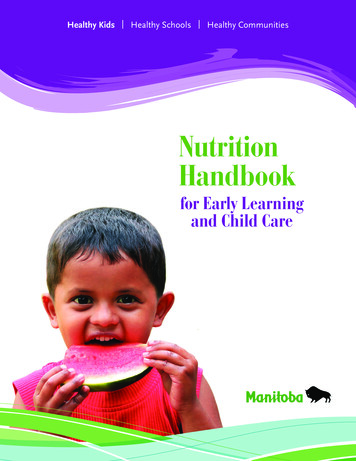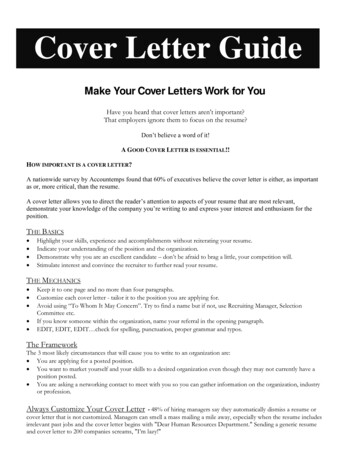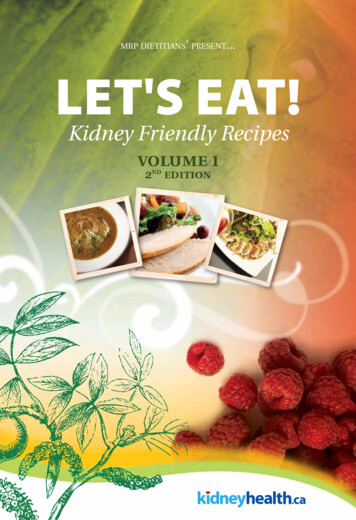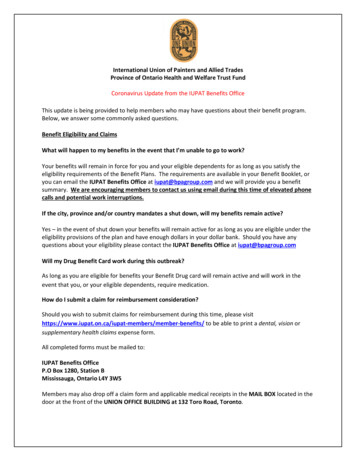
Transcription
Healthy Kids Healthy Schools Healthy CommunitiesNutritionHandbookfor Early Learningand Child Care
Nutrition Handbookfor Early Learningand Child CareIntroductionAbout this manual3Acknowledgments3Allergy disclaimer4Using the appendix4Building Relationships with Familiesii35Learn about families’ needs5Support families5Share nutrition information with families5Involve families in facility activities6Inform families about foods their children are eating7Talk with families about sensitive food issues7
Food and Nutrition: What You Need to Know9Important facts about nutrition and children9Portion sizes9Infant feeding (ages 0 - 2)10Beverages12Choking hazards13Protecting children with food allergies14“Picky” eater at the table16Culture, religion and food18Vegetarian diets19Food and Nutrition: Putting it into Practice21What is your role?21Involving children in food preparation22Family-style dining23Menu-planning tips24Menu ideas: meal by meal26Healthy snacks28Pre-prepared foods30Dips, sauces and condiments31Lunch and snacks from home34Special occasions and celebrations351
AppendixFood and Nutrition Questions for FamiliesFood Journal for InfantsFood Journal for ChildrenReading Food LabelsSnack IdeasLunch IdeasTasty Tips to Transform Your RecipesRecipesHelpful Websites/ResourcesReferences2
IntroductionEarly learning and child care facilities can have apositive effect on children’s health by: making sure young children are offerednutritious foods influencing food choices and attitudes supporting children’s growth anddevelopment providing resources to help supportfamiliesAbout this manualBy working with families, and focusing oncreating a healthy eating environment in yourfacility, you can also have a positive effect onchildren’s home lives. You have the opportunityto influence children’s learning ability andgrowth, and improve their present and futurehealth.This handbook will help you to: build relationships with families learn more about the nutrition challengesyou face provide children with healthy, nutritiousfood choices create a healthy eating environmentThe Best Practices Licensing Manuals for EarlyLearning and Child Care Centres and Homesoutline licensing regulations, guidelines andbest practices.This handbook supports the Best PracticesLicensing Manuals by providing practical advicethat can be adapted to meet the individualneeds of each facility.AcknowledgmentsThank you to all the registered dietitians andthose in the early learning and child care fieldwho contributed their knowledge, experienceand ideas to this handbook.3
Allergy disclaimerUsing the appendixThe snack and meal suggestions in thishandbook do not leave out common foodallergens (ex: peanuts, tree nuts, eggs, milk,seafood, mustard, soy, wheat, sulphites). Ifa child in your care has a known food allergy,consult with the child’s family. The list ofresources below will help you keep thesechildren safe while in your care. Allergy/Asthma Information Association:www.aaia.ca/en/index.htm Anaphylaxis Canada: www.anaphylaxis.ca/Throughout this handbook, you will findreferences to an appendix. It is located near theend of the handbook. Government of Manitoba. Caring for ourchildren with anaphylaxis in a child careprogram: www.gov.mb.ca/fs/childcare/pubs/anaphylaxis booklet.pdf Health Canada: ng.phpNOTE: Information on protecting children withfood allergies can also be found on page 14 ofthis handbook.Research shows it is not necessary forfamilies to wait before giving fish, eggs orother foods to babies/children – it will notreduce or prevent allergies to these foods.(Feeding Your Baby: 6 months-1 year,Healthy Child Manitoba, 2014)Licensed child care providers in Manitobamust NOT serve food containing knownpeanut products to children younger thanthree years of age.Child care providers must only serve foodsthat children have already eaten at home.Therefore, it is important to talk to familiesregularly about which new foods theirchildren have been introduced to.4Listed in the appendix are ideas and materialsthat will support what you’ve learned in thehandbook. Use these materials to put thatknowledge into practice (ex: blank forms, snackand lunch ideas, recipes). Photocopy pages,when needed, for use in your child care facilityor as handouts for families.*All materials in this handbook can bephotocopied for use.
Building Relationshipswith FamiliesFamilies face many different challenges,including busy schedules, difficult financialsituations and limited help and support. As achild care provider, it’s important that you builda relationship with families. This will help youto better understand their circumstances andprovide the best possible nutritional care fortheir children.When you work with families, you have anopportunity to: encourage healthy eating in their homes provide children with positive messagesabout nutrition and their eatingenvironment learn from each other, so you can bestmeet the needs of the children under yourcareHere are some ways to strengthen, and build on,relationships with families:Learn about families’ needs Ask families about their children’s foodpreferences, and whether there are foodsthey must not eat due to allergies, ormedical conditions (ex: celiac disease ordiabetes). Learn about families’ cultural and religiouspractices that concern food (ex: foodrestrictions, mealtime customs/rituals,recipes for their favorite family dishes). Use the list of food and nutrition questionsfor families in the appendix to gatherinformation. The questions can be includedin the enrollment forms, or collected afterthe children are accepted into your care.Use the information you receive to planmenus.Support families Create opportunities for families to sharesnack and meal ideas. Distribute throughnewsletters or a website. Organize a nutrition information event. Help families access affordable, healthyfoods. Share tips for menu planning on a budget(see pages 24-25).Share nutrition information withfamilies Share all changes in menus, schedules,policies, food allergies as well asrestrictions on food brought from home. Share your facility’s food and nutritionpolicy (if you have one). Share nutrition information and otherhelpful resources. Share snack and lunch ideas (seeappendix).5
Involve families in facility activities Ask families to share their children’sfavourite recipes made from fresh, wholefoods, and use them in your menus. Invite families to drop in for lunch. Plan field trips to places where food isgrown or sold (ex: farm, farmer’s market,grocery store) and invite families to come. Start a gardening project. Invite families totake part by providing seeds or plants, orby taking home seedlings the children havegrown. Allow children to share things like storiesabout special family members they like tocook with or food and their heritage. Theycould also share favorite family recipes,photos, or vegetables and fruit from familygardens.6 Ask children to bring in photos or drawingsof themselves and their families sharing ameal, or doing activities that involve food.Post these on a bulletin board to sharewith the other children and their families. Ask families for their opinions whenmaking changes to your nutrition policyor menus, and give them time to adjust toany changes.
Inform families about foods theirchildren are eating Keep menus posted so families are awareof the foods their children are beingoffered. Keep track of what children are eating atyour facility. This will promote well-roundeddiets, which are important for their overallhealth and well-being. Let families know what their children haveeaten while in your care, by telling them, orproviding them with a written food journal.Food journal for infants Provide a written journal for all infants, thatfamilies can take home daily. Record food, milk and water intake, napsand diaper changes so families can plan forthe rest of the day. See appendix for a food journal for infantsyou can photocopy and use in your facility.Talk with families about sensitive foodissues Listen to families’ concerns right away, in aprivate setting. Be sensitive to families’ circumstances,cultural practices and religious beliefs. Be respectful when suggesting differentideas and options. Be realistic about families’ busy schedulesand the realities of parenting. See page 34 for tips to improve lunchesand snacks coming from home. Contact your child care co-ordinator orlocal public health office for help, if needed. Get help from a registered dietitian.Food journal for children Food journals for children would likely beused temporarily – when challenges arise. Food journals can be helpful when workingwith “picky” eaters or children with foodallergies. They are also useful whenchildren are ill. Knowing what their children have eatenwhile in your care will help families tobalance their food intake at home. You could consider printing out your menufor the day to communicate to parentshow much of each food their childrenhave eaten, or photocopy the form in theappendix and use it in your facility.7
8
Food and Nutrition:What You Need to KnowImportant facts about nutrition andchildren Follow Canada’s Food Guide when planningmeals and snacks, for children 2 yearsand older (see appendix, under HelpfulWebsites/Resources, for link to Canada’sFood Guide). Children need good role models to developa taste for healthy foods and a healthyattitude about food. Children’s growing bodies need healthy fatfound naturally in foods like higher-fat milk,cheese, nuts and vegetable oils. Children need healthy, nutritionallybalanced breakfasts to give them the energythey need to learn and play. Children need variety, including:-- choices from each food group-- foods with a variety of colour, texture (ex:crunchy, soft, chewy) and temperature Limit foods high in added sugar, salt andfat, such as sweetened cereal, packagedbaked goods, candy, sweetened drinks,deep-fried foods and processed deli meats.These foods will fill a child’s stomach,making them less hungry for nutrient richfood and drinks.Portion sizesIn healthy children, portion size will increasewith age.A Canada’s Food Guide serving may be largerthan a young child can eat at one time. Startwith 1 3 to ½ of a Canada’s Food Guide serving.If a child is still hungry, allow them to havemore.For example:Children between two and eight years of ageneed one Canada’s Food Guide serving from themeat and alternatives group per day.This could mean:1 egg OR 1 Tbsp nut butter, at lunch(½ Canada’s Food Guide serving)AND40 grams (1 ¼ ounce) fish, poultry or meat,at supper (½ Canada’s Food Guide serving)Keep in mind that a large portion of a child’sdaily food intake is eaten at home.DID YOU KNOW?Canned light tuna contains types of tuna that are low in mercury, so no safety guidelinesare necessary. Also, it is usually lower in cost.Canned white tuna is not the same as canned light tuna.Limit the amount of white tuna to: 75 grams a week (or one Canada’s Food Guide serving, about half a 170-gram can) forchildren ages one to four years. 150 grams a week (or two Canada’s Food Guide servings, about one 170-gram can) forchildren ages 5 to 11.9
Infant feeding (ages 0 - 2)Formula feedingDaily communication with families can helpan infant’s overall health and well-being. Askfamilies about their feeding preferences; workwith them to develop a feeding plan for theirinfants; and discuss which foods have beenintroduced at home.For mothers who are not breastfeeding, ironfortified infant formula is the next best choice.Infants who are fed formula should continue tohave formula until they are nine months to oneyear old, at which time they may be ready forwhole cow’s milk (3.25% MF).BreastfeedingBreastfeeding is the ideal way to feed a baby.Health Canada recommends breast milk as theonly food babies should consume until they aresix months old, with continued breastfeeding fortwo years, or longer.Support breastfeeding mothers and theirchildren by: welcoming breastfeeding mothers intoyour facility offering them a quiet and comfortableplace to sit and feed their children encouraging them to send expressedbreast milk from home, if possible10DID YOU KNOW?You should NEVER give any type of honeyto infants 12 months old and younger.Feeding babies honey before they are oneyear old has been linked to a rare, butserious, form of food poisoning calledInfant Botulism.
Introducing solid foodsWhen infants are six months old, they areusually ready to start eating small amountsof solid foods containing iron. Solid foodsprovide nutrients and textures needed forhealthy growth and development. At this time,breast milk and/or formula with iron shouldstill be baby’s main food.SIGNS AN INFANT IS READY FOR SOLIDFOODSThey: sit up with very little help hold their head up open their mouth when food is offered turn their head to refuse foodFeeding tips Choose foods and textures that suit baby’sskills and age. It is important to try different textures.This helps baby to learn to chew, swallowand enjoy the same food other children areeating. Babies do not need to have teeth to eatsolid foods. If using store-bought baby food, check theexpiry date on the jar or package. Do notuse past the expiry date. Use a small bowl or plate for feeding baby.Do not feed babies from the jar. Any food left over should be thrown out asgerms can spoil the food. When warming baby food, stir and test it tomake sure it is not too hot. Put a small amount of food in front of babyand see what happens. They may play withit, taste it or not eat it at all. Start with one or two teaspoons of foodand gradually increase according to baby’sappetite. Let baby decide how much to eat. Start with one meal a day and graduallyincrease to three meals a day and snacks. Babies do not need sugar, sweeteners orsalt added to food. Try only one new food at a time. Waitat least two days before trying anothernew food. This helps you find out if afood causes an allergic reaction. Talk tothe family about what foods are beingintroduced at home. Work closely with families to create a planfor introducing new foods.(adapted from Feeding your Baby: 6 Months to1 Year, Healthy Child Manitoba ding.pdf)11
BeveragesMilk Whole cow’s milk(3.25% MF) can beintroduced after ninemonths of age. Reduced-fat milk(2%, 1% or skim) andfortified soy beveragescan be introduced aftertwo years of age (discusswith family beforechanging the type ofmilk served). Children who drink more than 3 cups ofmilk a day may not be hungry for foodand therefore may not be getting othernutrients their bodies need.Water Once an infant is six months of age, watermay be introduced as a beverage. Water given to infants (for drinking and/orpreparing food and other beverages) mustbe clean and safe from contamination. Offer water to satisfy thirst.DID YOU KNOW?Infants over one year of age do not need touse a bottle or “sippy cup” (cup with a lid).A regular (open) cup is the best choice toencourage development of mature drinkingskills, a healthy diet and good dentalhealth.12Fruit juice Fruit juice is not recommended for infantsunder six months of age. Vegetables and fruit should be offeredmore often than juice. If juice is served to children or infants aftersix months of age:-- offer only a small serving (about 60 - 125ml or ¼ - ½ cup)-- the daily amount should not exceed125 - 175 ml (or ½ - ¾ cup); keep in mindthat they may be drinking juice at home,too-- offer in a cup, not a bottle-- only offer as part of a meal, or snack-- offer only 100% fruit juice-- never serve un-pasteurized juice Do not serve beverages called “fruitcocktail,” “fruit punch” or “fruit drink.”They are not a food-group choice and arehigh in added sugar. Too much fruit juice will fill a child’sstomach, making them less hungry fornutrient-rich breast milk, infant formula,milk and healthy foods.Sweetened drinks Sugar-sweetened beverages like pop/softdrinks, fruit punch, flavoured water, icedtea, lemonade, sports drinks, and drinkssweetened with artificial sweetener, are notrecommended for children. When children fill up on these beverages,there is little room left for nutritious foodand drinks.
Choking hazardsAs infants and young children learn to eat, they should always be supervised and seated inappropriate, child-sized chairs to reduce the risk of choking. Remember that children move throughstages at their own rate. By watching children closely, you will be able to judge when they are ready forcertain foods.The foods below cause the greatest risk of choking for children under four years old. Therefore, thesefoods should either be altered to a safer shape or texture, or avoided altogether.Choking hazardHow to make it saferWhole or large pieces of raw vegetables,fruit and breadGrate raw vegetables or fruit.Kabobs (on a skewer or toothpick)Cook to soften.Remove pits and large seeds.Cut into very small pieces – about 1 cm (½ in) diameter.Cut up vegetables and fruit and serve them on a plate,rather than on a skewer or toothpick.GrapesCut into quarters, lengthwise, and remove seeds.Foods with fibrous or stringy texturessuch as celery or pineappleFinely chop these foods.Raisins and other dried fruitDo not give to children under four years old.PopcornDo not give to children under four years old.Seed and nut butter spread thickly orserved on a spoonSpread thinly on a cracker or breadWhole nuts and seedsDo not give to children under four years old.Fish with bonesCarefully remove all bones.Wieners or sausagesCut into quarters, lengthwise, then into bite-size pieces(or do not serve).Gum, marshmallows, hard candy andcough dropsDo not give to children under four years old.Provide first aid and call 911 if a child is choking.13
Protecting children with food allergiesHow will caring for children with foodallergies affect the way I do things?Caring for a child with a food allergy requiresextra attention.If your facility provides food: be sure all staff are aware of the foodallergy, and what is being done to avoidexposure to the allergen (substances thatcan cause allergies in some children) pay very close attention to food labelswhen shopping (see appendix for moreinformation on reading food labels) focus your menu on whole, fresh foods andhomemade sauces, seasonings and dips,to help avoid allergens communicate with all families about foodallergies present in the facilityIf families are providing food for their children: make sure all families are aware of the foodallergies at your facility inform families about how to avoidbringing food allergens into the child carefacility, and what the possible risks are ifthe allergic child is exposedAlso keep food allergies in mind when: planning activities (ex: avoid using foodfor art) organizing special events and field tripsWhat steps can I take to protect a child whohas food allergies?If a child in your care has a known food allergy,there are many important steps you can take tohelp protect them:1. Read food labels very carefully. Make sure you check the label every timeyou buy a product!-- Manufacturers sometimes change theingredients in products.-- Different varieties and sizes of the samebrand may contain different ingredients,so check the label on every product youbuy.14
Most packaged food products mustidentify major food allergens on the label.Read ingredient lists and look for thefollowing cautionary statements/warnings:-- “contains.”-- “may contain ”-- “manufactured in a facility which alsoprocesses ”Note: Less common food allergens donot have to be identified in a cautionarystatement. Look for them in the ingredientlist. Avoid buying food from bulk bins, asingredient lists may not be available andthere is a risk of cross-contaminationbetween bins.See appendix for more information on readingfood labels.2. Avoid cross-contaminationCross-contamination happens when an allergenaccidentally comes into contact with a foodproduct that doesn’t normally contain thatallergen. Cautionary statements on food labels warnthat foods could have accidentally beenexposed to an allergen some time duringthe manufacturing process, and are notsafe for those with food allergies. Even if a food does not contain the foodallergen, it still might have been in contactwith the allergen through things likeutensils (ex: forks, knives) and cookingpans. To avoid cross-contamination in yourfacility, you could consider eliminating allfoods containing the known allergen.3. DO NOT take chancesWhen in doubt, don’t serve it! Avoid serving food products that contain,or may contain, an allergen a child in yourcare is allergic to. Avoid serving food products that contain awarning statement naming an allergen ofconcern. Avoid serving food products that don’t listtheir ingredients.Where can I find more information aboutfood allergies?See the list of helpful websites on page 4.DID YOU KNOW?Substitutes for peanut butter include:soy butter (ex: WowButter ), pea butter,sunflower seed butter (ex: SunButter )and nut butters (ex: almond, hazelnut).These products provide similar amounts ofprotein and fat as peanut butter, and havea similar taste and texture.Before allowing these foods into yourfacility, check with families for allergiesto the ingredients in them (ex: soy, nuts).Also, some of these foods may have comein contact with peanuts during processing.Be sure to read the food labels every time!15
“Picky” eater at the tableTry not to label a child as a “picky” eater; theyare simply learning to eat. Many children gothrough stages where they refuse to eat some, orall, of the food offered to them. Learning to bean adventurous eater takes time and patience.Remember that if children are growing andsleeping well, and are happy and healthy, theyare probably getting the food they need. If youhave concerns, try some of these ideas:1. Work closely with families. Communicate regularly about successesand challenges concerning food andeating. Work with families to apply the samestrategies at home and at child care, toprovide a consistent and reliable message. Try to have discussions about food andeating challenges when children are notpresent.2. Create a positive eating environment. Be role models and encourage healthyeating habits. Children learn by imitation. Give children about 10 to 15 minutes noticebefore the meal or snack is going to start. Allow children as much time as they needto eat. Sit at the table with the children, and eatthe same food (when possible). Allow children to serve themselves, whenthey can. Give them the opportunity tochoose how much, or how little, of eachfood they would like. Allow them to haveanother helping if they are still hungry. Keep mealtimes as pleasant and relaxed aspossible (ex: start up conversations). Limit distractions at the table. Children willfocus better on eating without other thingsgoing on like the television, telephone,computer and toys. Avoid entertaining children duringmealtime (ex: singing songs, readingbooks).DID YOU KNOW?It can take at least eight to ten exposuresbefore children try a new food. Continue tooffer a food even if it’s not accepted the firsttime.16
3. Try to make sure children come to the tablefeeling hungry. Offer only small snacks halfway betweenmeals or, if possible, two hours beforemeals. Offer only water in between meals andsnacks (ex: don’t leave out a bowl of cut-upfruit, dry cereal or crackers for the childrento munch on). Include physical activity throughout theday.4. Other tips The amount of food eaten at each mealand snack will vary day to day, dependingon the child’s appetite, activity level,growth, and whether they are excited ortired. Trust children to know when they arehungry and when they are full. Try to serve food in a variety of differentways. For example:-- Add vegetables to soups, casseroles andsauces; or try them raw, shredded, baked,mashed or with a dip.-- Try adding meat (ex: beef, pork) orpoultry (ex: chicken, turkey) – choppedinto small, bite-size pieces – to acasserole, soup or sandwich. Also tryground meat or poultry in a sauce. Offer new foods with familiar foods. Be open about the ingredients inmixed food dishes (ex: spaghetti sauce,meatloaf). Don’t try to hide or disguisevegetables or other ingredients. This cancause the child not to trust you. Involve children in meal planning andpreparation, according to their abilities.When they have been involved in preparingthe food, they are more likely to taste it.See pages 22 - 23 for informationabout involving children in foodpreparation. Make only one meal but try to include atleast one food you know all the childrenwill eat. Sit children together in small groups. Theymay be more likely to try new foods if theirfriends are eating them.DID YOU KNOW?Eighty (80) per cent of five-year-oldchildren are thought to be “picky” eaters,but by seven years of age, only 23 per centremain “picky”. Be patient!17
Culture, religion and foodChildren in your care may come from a varietyof cultural and religious backgrounds. Trying tounderstand and include children’s cultural andreligious food traditions or restrictions (foodsthey don‘t eat) will help them feel accepted andvalued.The role of food in cultural and religiouspractices is not simple – it varies amongindividuals and communities. It’s not possibleto know every cultural or religious traditionor celebration that involves food. The mostimportant thing you can do is learn from thefamilies of the children in your care. Here aresome steps you can take to learn about, andsupport, all children in your care: Do not assume that all children from aparticular culture or religion follow thesame traditions. Ask children and theirfamilies to tell you about any cultural orreligious food traditions or restrictions thatthey follow. Ask families to share a couple of theirchildren’s favourite cultural recipes withyou. Learn how to cook them and includethe ones made with whole, fresh food inyour regular menus. Accept that some children may not want totry traditional Canadian foods, and othersmay not want to try foods from differentcultures.18 Participate in some of the children’scultural celebrations by buying or preparinga special dish or snack. Always make sure there are suitablechoices for all children. See the section called Helpful Websites/Resources in appendix for recipe ideasfrom a variety of different cultures.
Vegetarian dietsWhat about vegan diets?The term “vegetarian” means different thingsto different people. Typically, vegetarians don’teat animal foods, including meat, fish, seafoodand poultry; however, they may eat dairy andeggs. Children and families follow vegetariandiets for a number of reasons – they includeenvironmental, cultural, religious, ethical orpersonal choice. It is important to supportchildren and families in their choices. Find outfrom families which foods can be included intheir children’s diet.A vegan diet is the same as a vegetarian dietbut does not include foods of animal origin (ex:meat, poultry, fish, eggs, milk, cheese, dairyproducts). A vegan diet can be healthy if foodsare chosen wisely to support a child’s growthand development.Like all children, children following a vegetariandiet need to eat a variety of foods for growth anddevelopment. The nutritional needs of thesechildren are the same as those of non-vegetarianchildren. Follow the recommendations inCanada’s Food Guide, using meat alternativesinstead of meat.In addition to replacing meat with meatalternatives (listed here), for vegan diets you willalso need to replace milk and milk products withalternatives such as fortified soy beverages. Talkto the family to find out what is served in thehome.Also, consult with families to determine whichingredients to be aware of when reading foodlabels and choosing acceptable packaged foodproducts. See appendix for more information onreading food labels.Meat alternatives include: peanut butter and other nut butters nuts and seeds pulses (ex: dried or canned beans, peas,chickpeas or lentils) tofu soy-based meat substitutes (ex: meatlessburgers, meatless ground round) fish * eggs **Some vegetarians do not eat fish or eggs.Check with the family before serving these foodsto children who are vegetarian.If possible, avoid making separate meals forvegetarian children. Instead, replace meat withalternatives or find vegetarian choices the wholegroup can enjoy.19
20
Food and Nutrition:Putting it into PracticeWhat is your role?Child care providers play an important role inyoung children’s experiences with food andeating. By setting a good example, creating apleasant eating environment and providingnutritious choices, you can strongly influencechildren’s overall health and well-being – nowand into the future.Here are some things you can do: Be role models for healthy eating. Childrenare more likely to enjoy a variety of foodand try new foods if they see you doing it. Be aware of food allergies and what couldtrigger allergic reactions, and share theinformation with everyone who needs toknow. Respect families’ individual needs andpersonal choices (ex: medical – allergies,celiac disease; religious or cultural foodrestrictions; vegetarian diets). Create relaxed and pleasant mealtimes thatprovide an environment for social learningand positive interaction. Offer a variety of foods, including foodswith different colours, textures, flavours,sizes, shapes and temperatures, as well asdifferent ethnic choices. Hold infants during bottle feeding – look atthem, talk to them and cuddle them. Actively involve children in mealtimeactivities (ex: setting the table, servingfood, cleaning up). Sit with children in small groups duringsnack and mealtimes whenever possibleand start conversations. Encourage communication a
Food and Nutrition: What You Need to Know 9 Important facts about nutrition and children 9 Portion sizes 9 Infant feeding (ages 0 - 2) 10 Beverages 12 Choking hazards 13 Protecting children with food allergies 14 “Picky” eater at the table 16 Culture, religion and food 18 Vegetarian diets 19 Food an










